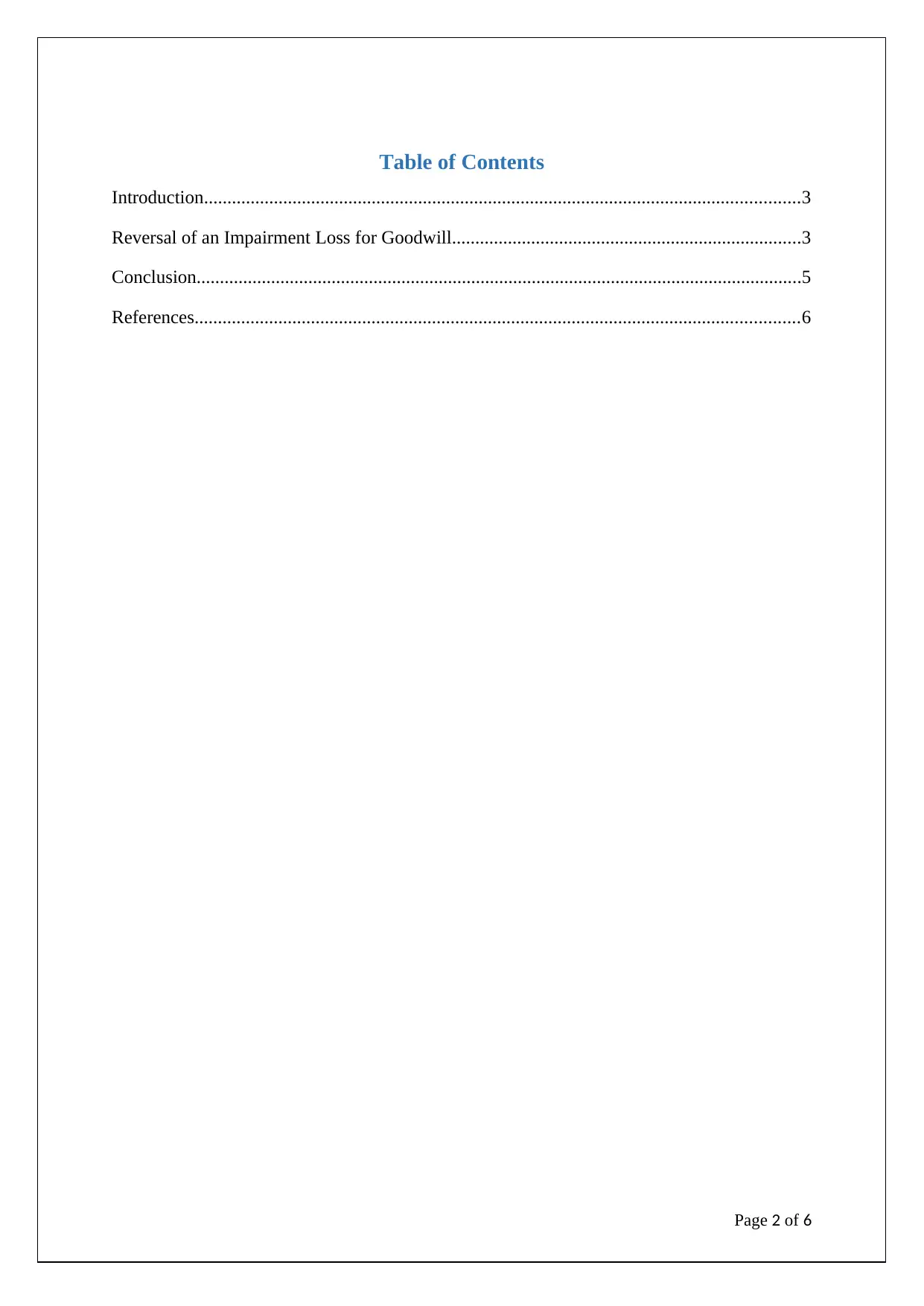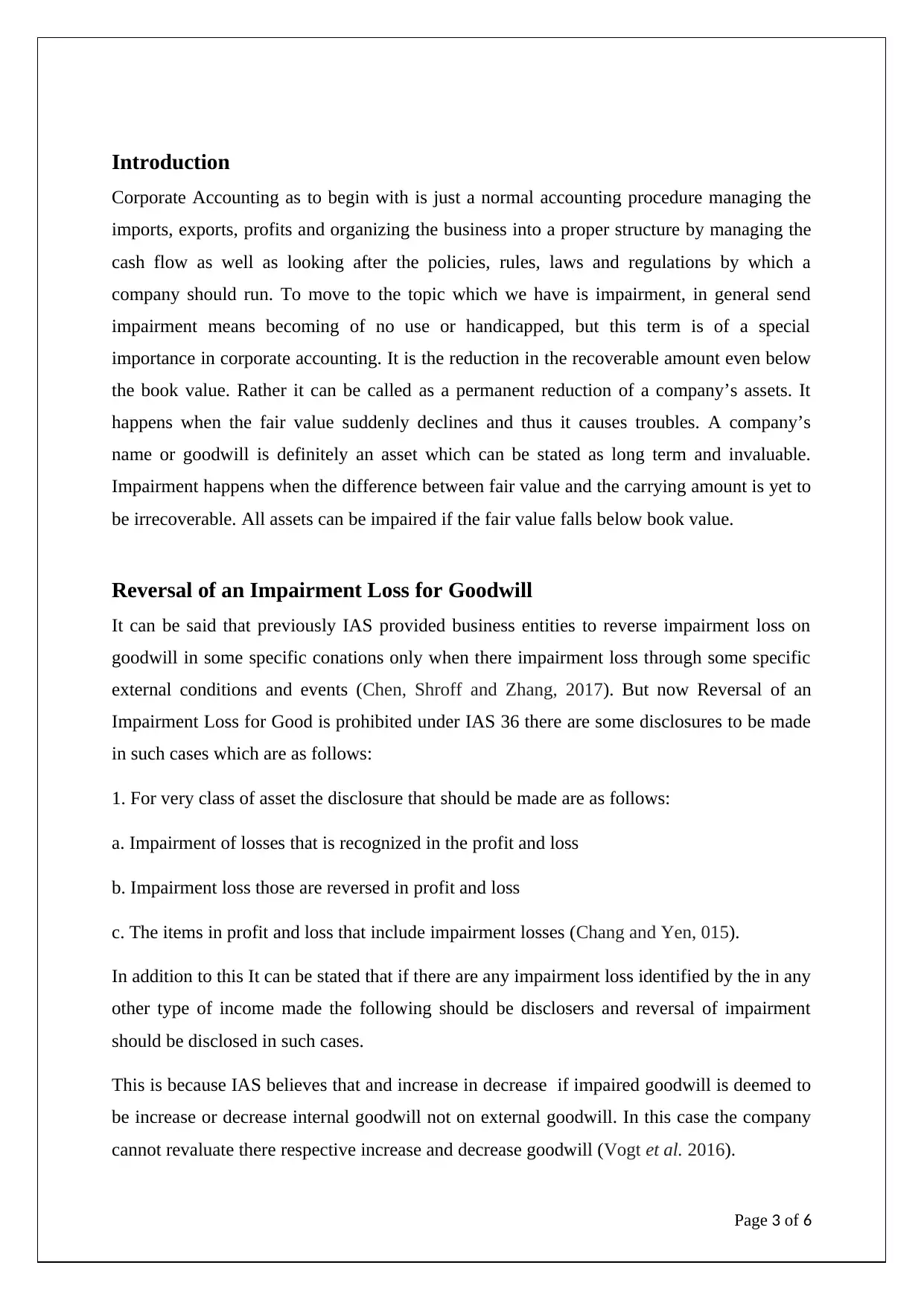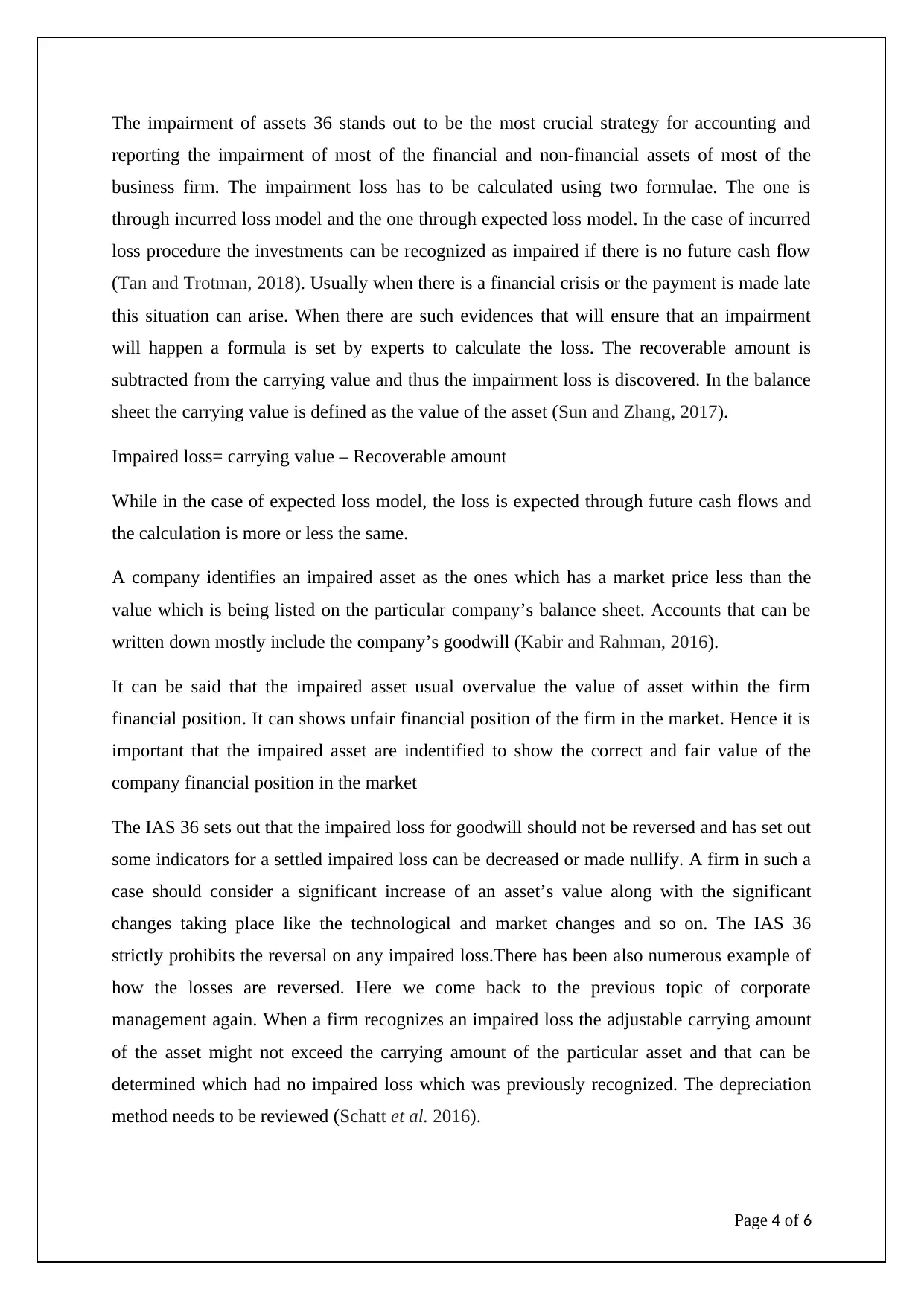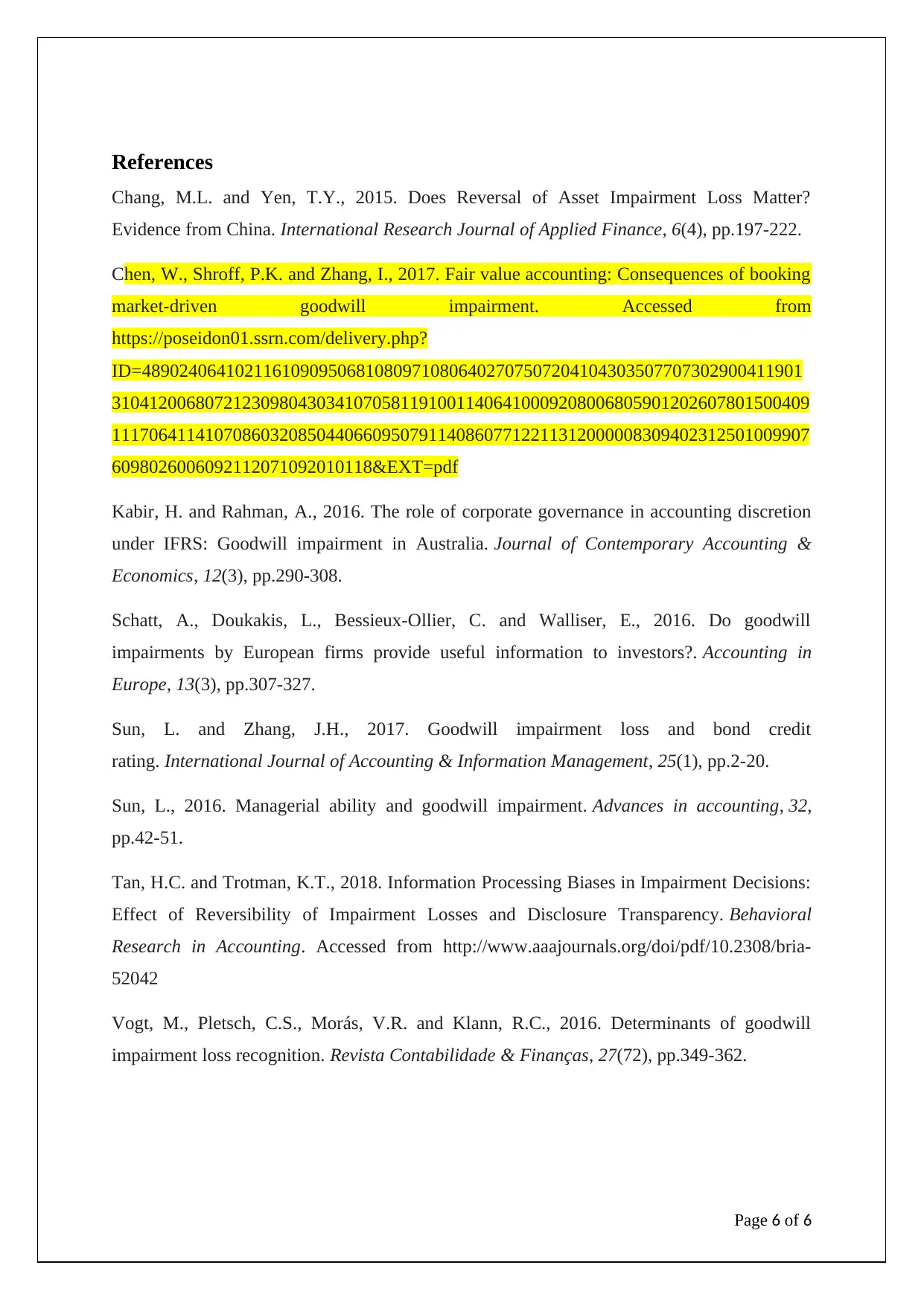Corporate Accounting: Goodwill Impairment and Loss Reversal Analysis
VerifiedAdded on 2023/06/07
|6
|1456
|282
Report
AI Summary
This report delves into the concept of goodwill impairment within corporate accounting, explaining its significance as a reduction in the recoverable amount of an asset below its book value. It highlights the importance of goodwill as a long-term intangible asset and the implications of impairment, particularly when the fair value declines. The report focuses on the prohibition of reversing impairment losses on goodwill under IAS 36, detailing the required disclosures. It further explains the calculation of impairment loss using both incurred and expected loss models, emphasizing that impaired assets often overstate a firm's financial position. The report concludes by summarizing the implications of non-reversal of goodwill impairment and the ethical and practical considerations involved, emphasizing that the IAS has made this decision to simplify the accounting process.

CORPORATE ACCOUNTING
Paraphrase This Document
Need a fresh take? Get an instant paraphrase of this document with our AI Paraphraser

Table of Contents
Introduction................................................................................................................................3
Reversal of an Impairment Loss for Goodwill...........................................................................3
Conclusion..................................................................................................................................5
References..................................................................................................................................6
Page 2 of 6
Introduction................................................................................................................................3
Reversal of an Impairment Loss for Goodwill...........................................................................3
Conclusion..................................................................................................................................5
References..................................................................................................................................6
Page 2 of 6

Introduction
Corporate Accounting as to begin with is just a normal accounting procedure managing the
imports, exports, profits and organizing the business into a proper structure by managing the
cash flow as well as looking after the policies, rules, laws and regulations by which a
company should run. To move to the topic which we have is impairment, in general send
impairment means becoming of no use or handicapped, but this term is of a special
importance in corporate accounting. It is the reduction in the recoverable amount even below
the book value. Rather it can be called as a permanent reduction of a company’s assets. It
happens when the fair value suddenly declines and thus it causes troubles. A company’s
name or goodwill is definitely an asset which can be stated as long term and invaluable.
Impairment happens when the difference between fair value and the carrying amount is yet to
be irrecoverable. All assets can be impaired if the fair value falls below book value.
Reversal of an Impairment Loss for Goodwill
It can be said that previously IAS provided business entities to reverse impairment loss on
goodwill in some specific conations only when there impairment loss through some specific
external conditions and events (Chen, Shroff and Zhang, 2017). But now Reversal of an
Impairment Loss for Good is prohibited under IAS 36 there are some disclosures to be made
in such cases which are as follows:
1. For very class of asset the disclosure that should be made are as follows:
a. Impairment of losses that is recognized in the profit and loss
b. Impairment loss those are reversed in profit and loss
c. The items in profit and loss that include impairment losses (Chang and Yen, 015).
In addition to this It can be stated that if there are any impairment loss identified by the in any
other type of income made the following should be disclosers and reversal of impairment
should be disclosed in such cases.
This is because IAS believes that and increase in decrease if impaired goodwill is deemed to
be increase or decrease internal goodwill not on external goodwill. In this case the company
cannot revaluate there respective increase and decrease goodwill (Vogt et al. 2016).
Page 3 of 6
Corporate Accounting as to begin with is just a normal accounting procedure managing the
imports, exports, profits and organizing the business into a proper structure by managing the
cash flow as well as looking after the policies, rules, laws and regulations by which a
company should run. To move to the topic which we have is impairment, in general send
impairment means becoming of no use or handicapped, but this term is of a special
importance in corporate accounting. It is the reduction in the recoverable amount even below
the book value. Rather it can be called as a permanent reduction of a company’s assets. It
happens when the fair value suddenly declines and thus it causes troubles. A company’s
name or goodwill is definitely an asset which can be stated as long term and invaluable.
Impairment happens when the difference between fair value and the carrying amount is yet to
be irrecoverable. All assets can be impaired if the fair value falls below book value.
Reversal of an Impairment Loss for Goodwill
It can be said that previously IAS provided business entities to reverse impairment loss on
goodwill in some specific conations only when there impairment loss through some specific
external conditions and events (Chen, Shroff and Zhang, 2017). But now Reversal of an
Impairment Loss for Good is prohibited under IAS 36 there are some disclosures to be made
in such cases which are as follows:
1. For very class of asset the disclosure that should be made are as follows:
a. Impairment of losses that is recognized in the profit and loss
b. Impairment loss those are reversed in profit and loss
c. The items in profit and loss that include impairment losses (Chang and Yen, 015).
In addition to this It can be stated that if there are any impairment loss identified by the in any
other type of income made the following should be disclosers and reversal of impairment
should be disclosed in such cases.
This is because IAS believes that and increase in decrease if impaired goodwill is deemed to
be increase or decrease internal goodwill not on external goodwill. In this case the company
cannot revaluate there respective increase and decrease goodwill (Vogt et al. 2016).
Page 3 of 6
⊘ This is a preview!⊘
Do you want full access?
Subscribe today to unlock all pages.

Trusted by 1+ million students worldwide

The impairment of assets 36 stands out to be the most crucial strategy for accounting and
reporting the impairment of most of the financial and non-financial assets of most of the
business firm. The impairment loss has to be calculated using two formulae. The one is
through incurred loss model and the one through expected loss model. In the case of incurred
loss procedure the investments can be recognized as impaired if there is no future cash flow
(Tan and Trotman, 2018). Usually when there is a financial crisis or the payment is made late
this situation can arise. When there are such evidences that will ensure that an impairment
will happen a formula is set by experts to calculate the loss. The recoverable amount is
subtracted from the carrying value and thus the impairment loss is discovered. In the balance
sheet the carrying value is defined as the value of the asset (Sun and Zhang, 2017).
Impaired loss= carrying value – Recoverable amount
While in the case of expected loss model, the loss is expected through future cash flows and
the calculation is more or less the same.
A company identifies an impaired asset as the ones which has a market price less than the
value which is being listed on the particular company’s balance sheet. Accounts that can be
written down mostly include the company’s goodwill (Kabir and Rahman, 2016).
It can be said that the impaired asset usual overvalue the value of asset within the firm
financial position. It can shows unfair financial position of the firm in the market. Hence it is
important that the impaired asset are indentified to show the correct and fair value of the
company financial position in the market
The IAS 36 sets out that the impaired loss for goodwill should not be reversed and has set out
some indicators for a settled impaired loss can be decreased or made nullify. A firm in such a
case should consider a significant increase of an asset’s value along with the significant
changes taking place like the technological and market changes and so on. The IAS 36
strictly prohibits the reversal on any impaired loss.There has been also numerous example of
how the losses are reversed. Here we come back to the previous topic of corporate
management again. When a firm recognizes an impaired loss the adjustable carrying amount
of the asset might not exceed the carrying amount of the particular asset and that can be
determined which had no impaired loss which was previously recognized. The depreciation
method needs to be reviewed (Schatt et al. 2016).
Page 4 of 6
reporting the impairment of most of the financial and non-financial assets of most of the
business firm. The impairment loss has to be calculated using two formulae. The one is
through incurred loss model and the one through expected loss model. In the case of incurred
loss procedure the investments can be recognized as impaired if there is no future cash flow
(Tan and Trotman, 2018). Usually when there is a financial crisis or the payment is made late
this situation can arise. When there are such evidences that will ensure that an impairment
will happen a formula is set by experts to calculate the loss. The recoverable amount is
subtracted from the carrying value and thus the impairment loss is discovered. In the balance
sheet the carrying value is defined as the value of the asset (Sun and Zhang, 2017).
Impaired loss= carrying value – Recoverable amount
While in the case of expected loss model, the loss is expected through future cash flows and
the calculation is more or less the same.
A company identifies an impaired asset as the ones which has a market price less than the
value which is being listed on the particular company’s balance sheet. Accounts that can be
written down mostly include the company’s goodwill (Kabir and Rahman, 2016).
It can be said that the impaired asset usual overvalue the value of asset within the firm
financial position. It can shows unfair financial position of the firm in the market. Hence it is
important that the impaired asset are indentified to show the correct and fair value of the
company financial position in the market
The IAS 36 sets out that the impaired loss for goodwill should not be reversed and has set out
some indicators for a settled impaired loss can be decreased or made nullify. A firm in such a
case should consider a significant increase of an asset’s value along with the significant
changes taking place like the technological and market changes and so on. The IAS 36
strictly prohibits the reversal on any impaired loss.There has been also numerous example of
how the losses are reversed. Here we come back to the previous topic of corporate
management again. When a firm recognizes an impaired loss the adjustable carrying amount
of the asset might not exceed the carrying amount of the particular asset and that can be
determined which had no impaired loss which was previously recognized. The depreciation
method needs to be reviewed (Schatt et al. 2016).
Page 4 of 6
Paraphrase This Document
Need a fresh take? Get an instant paraphrase of this document with our AI Paraphraser

It can be said that impairment of intangible assert like Goodwill are very common in context
of firm which operate in various regional areas or has diverse location of operation. It can be
said that in this the carrying weights. It can be said that in this the firm is subjected to
classifying weights that should be added to the impaired assets. It Can be said that impaired
asset like Goodwill ha complexities such as their increasing decrease weights which why the
complexity might results in over and under valuation of goodwill if they are reversed. In this
case it can be said for simplifying accounting for impairment of intangible asset reversal on
intangible asset like is prohibited that is a good option to simplify the accounting process
(Sun, 2016).
Conclusion
Concluding in the light of above context it can be said that impaired goodwill cannot be
reversed ethical although if there is reversal performed the company will have to perform and
report several disclosure to ensure that the reversal is properly reported. It can be said that for
decreasing the complexity of goodwill impairment calculation the IAS has made profitable
choice. This will make the amount of impaired asset more reasonable and flexible. In this
way the impaired assets will be more in the appropriate for proper valuation fo goodwill and
intangibles asset in the balance sheet of the firm.
Page 5 of 6
of firm which operate in various regional areas or has diverse location of operation. It can be
said that in this the carrying weights. It can be said that in this the firm is subjected to
classifying weights that should be added to the impaired assets. It Can be said that impaired
asset like Goodwill ha complexities such as their increasing decrease weights which why the
complexity might results in over and under valuation of goodwill if they are reversed. In this
case it can be said for simplifying accounting for impairment of intangible asset reversal on
intangible asset like is prohibited that is a good option to simplify the accounting process
(Sun, 2016).
Conclusion
Concluding in the light of above context it can be said that impaired goodwill cannot be
reversed ethical although if there is reversal performed the company will have to perform and
report several disclosure to ensure that the reversal is properly reported. It can be said that for
decreasing the complexity of goodwill impairment calculation the IAS has made profitable
choice. This will make the amount of impaired asset more reasonable and flexible. In this
way the impaired assets will be more in the appropriate for proper valuation fo goodwill and
intangibles asset in the balance sheet of the firm.
Page 5 of 6

References
Chang, M.L. and Yen, T.Y., 2015. Does Reversal of Asset Impairment Loss Matter?
Evidence from China. International Research Journal of Applied Finance, 6(4), pp.197-222.
Chen, W., Shroff, P.K. and Zhang, I., 2017. Fair value accounting: Consequences of booking
market-driven goodwill impairment. Accessed from
https://poseidon01.ssrn.com/delivery.php?
ID=48902406410211610909506810809710806402707507204104303507707302900411901
310412006807212309804303410705811910011406410009208006805901202607801500409
111706411410708603208504406609507911408607712211312000008309402312501009907
6098026006092112071092010118&EXT=pdf
Kabir, H. and Rahman, A., 2016. The role of corporate governance in accounting discretion
under IFRS: Goodwill impairment in Australia. Journal of Contemporary Accounting &
Economics, 12(3), pp.290-308.
Schatt, A., Doukakis, L., Bessieux-Ollier, C. and Walliser, E., 2016. Do goodwill
impairments by European firms provide useful information to investors?. Accounting in
Europe, 13(3), pp.307-327.
Sun, L. and Zhang, J.H., 2017. Goodwill impairment loss and bond credit
rating. International Journal of Accounting & Information Management, 25(1), pp.2-20.
Sun, L., 2016. Managerial ability and goodwill impairment. Advances in accounting, 32,
pp.42-51.
Tan, H.C. and Trotman, K.T., 2018. Information Processing Biases in Impairment Decisions:
Effect of Reversibility of Impairment Losses and Disclosure Transparency. Behavioral
Research in Accounting. Accessed from http://www.aaajournals.org/doi/pdf/10.2308/bria-
52042
Vogt, M., Pletsch, C.S., Morás, V.R. and Klann, R.C., 2016. Determinants of goodwill
impairment loss recognition. Revista Contabilidade & Finanças, 27(72), pp.349-362.
Page 6 of 6
Chang, M.L. and Yen, T.Y., 2015. Does Reversal of Asset Impairment Loss Matter?
Evidence from China. International Research Journal of Applied Finance, 6(4), pp.197-222.
Chen, W., Shroff, P.K. and Zhang, I., 2017. Fair value accounting: Consequences of booking
market-driven goodwill impairment. Accessed from
https://poseidon01.ssrn.com/delivery.php?
ID=48902406410211610909506810809710806402707507204104303507707302900411901
310412006807212309804303410705811910011406410009208006805901202607801500409
111706411410708603208504406609507911408607712211312000008309402312501009907
6098026006092112071092010118&EXT=pdf
Kabir, H. and Rahman, A., 2016. The role of corporate governance in accounting discretion
under IFRS: Goodwill impairment in Australia. Journal of Contemporary Accounting &
Economics, 12(3), pp.290-308.
Schatt, A., Doukakis, L., Bessieux-Ollier, C. and Walliser, E., 2016. Do goodwill
impairments by European firms provide useful information to investors?. Accounting in
Europe, 13(3), pp.307-327.
Sun, L. and Zhang, J.H., 2017. Goodwill impairment loss and bond credit
rating. International Journal of Accounting & Information Management, 25(1), pp.2-20.
Sun, L., 2016. Managerial ability and goodwill impairment. Advances in accounting, 32,
pp.42-51.
Tan, H.C. and Trotman, K.T., 2018. Information Processing Biases in Impairment Decisions:
Effect of Reversibility of Impairment Losses and Disclosure Transparency. Behavioral
Research in Accounting. Accessed from http://www.aaajournals.org/doi/pdf/10.2308/bria-
52042
Vogt, M., Pletsch, C.S., Morás, V.R. and Klann, R.C., 2016. Determinants of goodwill
impairment loss recognition. Revista Contabilidade & Finanças, 27(72), pp.349-362.
Page 6 of 6
⊘ This is a preview!⊘
Do you want full access?
Subscribe today to unlock all pages.

Trusted by 1+ million students worldwide
1 out of 6
Related Documents
Your All-in-One AI-Powered Toolkit for Academic Success.
+13062052269
info@desklib.com
Available 24*7 on WhatsApp / Email
![[object Object]](/_next/static/media/star-bottom.7253800d.svg)
Unlock your academic potential
Copyright © 2020–2025 A2Z Services. All Rights Reserved. Developed and managed by ZUCOL.




